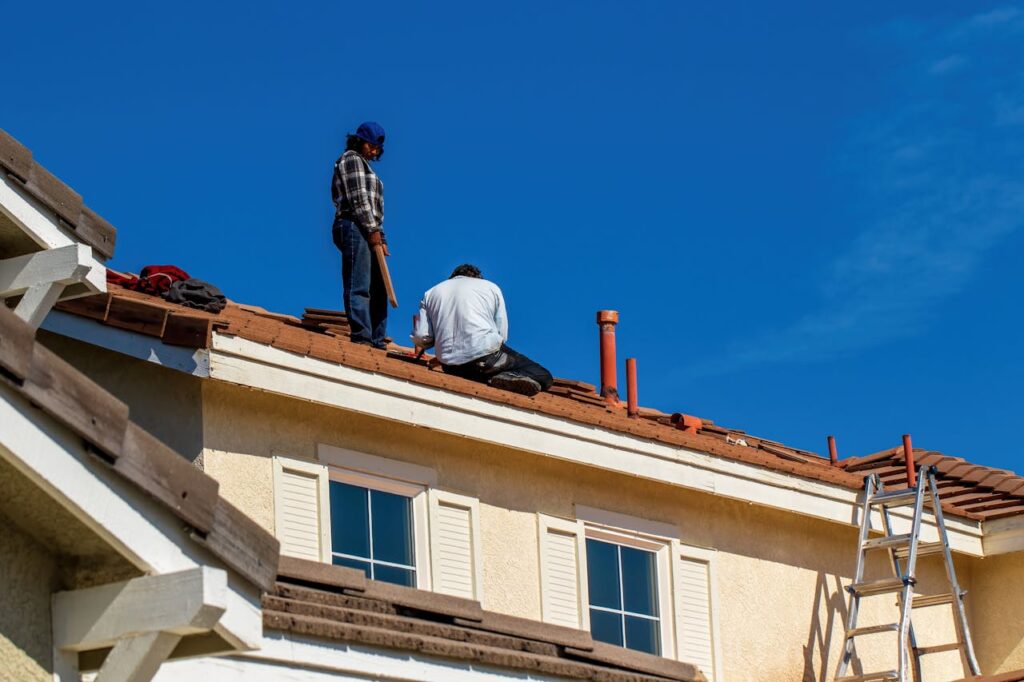Taking care of your roof is crucial for keeping your home safe and secure. We often overlook roof problems until it’s too late, leading to costly repairs. By spotting common roof problems early, we can prevent minor issues from turning into serious damage. This proactive approach saves time, money, and stress.
Many roof problems, such as shingle damage, water leaks, and structural issues, can be spotted with regular inspections. Understanding what to look for helps us identify these problems early on. This knowledge is valuable, especially during harsh Canadian weather, where our roofs endure heavy snow, rain, and strong winds.
In this guide, we will explore how to spot common roof problems before they escalate. By following these tips, we can ensure our roofs stay in good condition, keeping our homes safe and extending the life of our roofing systems.
Signs of Shingle Damage to Watch For
Recognizing shingle damage early is crucial for maintaining a healthy roof. Damaged shingles can lead to leaks and other serious issues. It’s essential to regularly inspect your shingles for any signs of damage. Here are some common indicators to watch for:
– Cracked Shingles: Cracks can appear due to weathering and age. Cracked shingles compromise the roof’s ability to protect your home from water and debris.
– Curling Shingles: Shingles that are curling at the edges need immediate attention. Curling can happen from exposure to extreme weather conditions or improper installation.
– Missing Shingles: Strong winds and storms can cause shingles to come loose and fall off. Missing shingles leave gaps in your roof, making it vulnerable to leaks.
– Granule Loss: If you notice granules from shingles in your gutters, it’s a sign of wear. Granule loss means the shingles are losing their protective quality and need replacement.
– Discolouration: Dark patches or streaks on shingles can indicate algae growth or areas where granules are missing. Discolouration often signals old or compromised shingles.
By regularly checking for these signs, we can address shingle damage before it develops into more severe problems.
Identifying Water Leaks and Moisture Issues
Water leaks and moisture issues are some of the most common and damaging roof problems. Spotting these issues early can save us from extensive repairs. Here’s how to identify water leaks and moisture problems in your roof:
– Ceiling Stains: One of the most obvious signs of a water leak is a stain on your ceiling. These stains can be yellow, brown, or grey and indicate that water has penetrated the roof.
– Dripping Water: If you see water dripping inside your home, it’s a clear sign of a leak. Even small drips can lead to significant damage over time.
– Musty Odours: A musty smell often means that there is moisture or mould in your home. This odour can come from water that has seeped into the roof and walls.
– Mould and Mildew: The presence of mould or mildew, especially in the attic, indicates a moisture problem. Mould can spread quickly and cause health issues.
– Peeling Paint or Wallpaper: Look for paint or wallpaper that is bubbling, peeling, or discoloured. This can happen when water seeps through the roof and into the walls.
By paying attention to these warning signs, we can catch water leaks and moisture issues early, preventing further damage and maintaining a safe living environment.
Signs of Shingle Damage to Watch For
Recognizing shingle damage early can prevent larger problems down the line. The most common sign to watch for is missing shingles. Spaces where shingles are missing can expose the underlying roof to the elements, leading to leaks and water damage. Cracked or curled shingles are also clear indicators of damage. These issues often result from extreme weather conditions, such as heavy winds or hail.
Another sign of shingle damage is granule loss. If you notice that your shingles appear to be balding or if you find granules in your gutters, it’s likely that your roof’s protective layer is deteriorating. This can make shingles less effective at shielding your home from weather. Shiny spots on shingles can also indicate that they are losing their protective granules. Monitoring these signs can help you address shingle damage before it becomes a serious issue.
Identifying Water Leaks and Moisture Issues
Water leaks and moisture problems are serious concerns that need immediate attention. You might detect leaks by inspecting your ceiling for water spots or stains. These marks often suggest that water is getting through the roof. Dark or damp patches on the walls, particularly near the ceiling, are also signs of moisture penetration. Additionally, if you see peeling paint or wallpaper, it could indicate underlying water damage.
Mould and mildew growth inside your home, especially in the attic, are clear indicators of moisture issues. They thrive in damp environments and can lead to health problems if not addressed. Other signs of water damage include a musty odour in the attic or other areas close to the roof. Performing regular checks and looking for these signs will help you identify and fix any water-related problems promptly, maintaining the health and safety of your home.
Conclusion
Maintaining a well-insulated roof is vital for the comfort and efficiency of your home. By regularly inspecting and maintaining your roof, you can catch potential issues early and avoid costly repairs. Recognizing signs of shingle damage, leaks, and moisture issues can help preserve your roof’s integrity and extend its lifespan. Simple steps such as cleaning gutters, trimming overhanging branches, and ensuring proper attic ventilation are easy yet effective ways to keep your roof in top shape.
Having a professional inspect your roof can provide peace of mind, ensuring that all potential issues are identified and addressed. At Full House Roofing, we are committed to helping you keep your home safe and comfortable. Contact our roofers in Kingston for expert advice and roofing services tailored to your needs. Your home deserves the best care, and we are here to provide it.

